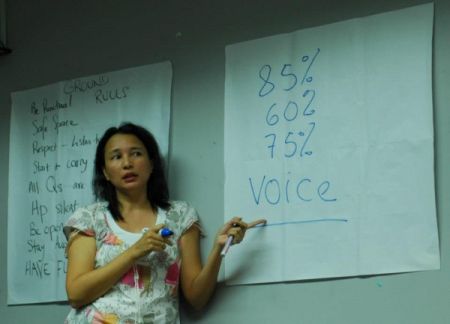Do you have a voice? Yes, you do. But have you really used your voice to protect yourself? Not sure.
Now, analyze the conversation between A and B below.
A: B, I want to tell you something but you keep it to yourself ok. I think… I think our boss had just fondled me. I was shocked, but he said there was something on my bum. This is not the first time actually. I feel uncomfortable.
B: Whoa. Are you okay? Just last week, C told me that boss stood closely beside her in an empty lift and said she is so tempting. Our boss is a jerk. Don’t you want to complain about this to the upper management? Have you spoke to boss about it?
A: No, I don’t dare to confront boss. I’m scared that I will risk my job. I’m too embarrassed to complain to the HR Department. They must think I’m lying. Or they’ll think it’s petty. Ah, I am so stressed!
Ever experienced the above scenario? Ever thought you would be involved in such incident? Well then, the scene above depicts the dilemma of a sexual harassment victim at workplace.
But what is sexual harassment? Is there a difference between harassment and sexual harassment? In what context can an act and/or acts amount to sexual harassment? Is it true that sexual harassment at the workplace occurs all the time without us realizing that we are being harassed by our colleagues?
More importantly, how do we avoid being further harassed and harassing our colleagues?
These are very common questions asked by ordinary workmen as the scenario if not often seen, is already at an alarming rate.

Considering the lack of awareness among workmen on sexual harassment at the workplace, PusatRakyat LoyarBurok took the initiative to organize “Harassment Free Policy Training” on 29 September 2012. Invited speakers and trainers were Betty, Program Manager of All Womens’ Action Malaysia (AWAM), Animah Kosai of Carigali Hess, and Lina, a hypnotherapist and former advocate and solicitor.
The objective of the training was to provide a conducive work environment that fosters mutual respect, fairness, integration and working relationships free of harassment.
About 20 enthusiastic and curious working Malaysians and students participated in the training, including LoyarBurokkers Edmund Bon, Fahri Azzat, Marcus van Geyzel, Lim Ka Ea, Seh Lih, and Pepper Lim, among others.

To begin with, Animah simplified harassment as inappropriate behavior or unwelcome conduct towards an individual. Harassment does not have to be of a sexual nature but it can amount to “sexual harassment” when there are unwelcome sexual advances, requests for sexual favors, and other verbal, non-verbal, visual, psychological or physical harassment of a sexual nature. Animah mentioned harassment includes bullying, acts of intimidation, abuse, humiliation, aggression, insults and assaults.
Betty of AWAM then described sexual harassment as any unwanted conduct of a sexual nature that on reasonable grounds could be perceived by a recipient as placing a condition of sexual nature on his/her employment related benefit and that could be perceived by the recipient as offensive, humiliating or a threat to his/her well-being. If you wish to know more about the notion of sexual harassment, you may visit http://www.un.org/womenwatch/osagi/pdf/whatissh.pdf.
Nonetheless, Lina reminded us not to confuse acts or speech which may contain sexual elements or aggression as not all of these acts constitute harassment. For example, Lina noted situations involving work performance management when an employee’s work performance is criticized by the employer as it is constantly below par or when colleagues are comfortable enough to make casual sexual jokes without one causing discomfort to the other.
But that poses a problem. Say if a lady boss comments to her male colleague: “Wow~ You look stunning in your suit today! If only you are not that young.. (laughs)” Is that sexual harassment? In my opinion, I think that statement is not sufficient to indicate sexual harassment. It is a casual comment between workmates, unless the male colleague is uncomfortable receiving such compliment.
Animah and Betty clarified that sexual harassment is subjective, in which it depends on what the recipient reasonably perceives regardless of the harasser’s intention. There is no specific context that automatically point(s) out acts as sexual harassment because circumstances differ from one workplace to another.
Ah… how then can we know whether we are harassing or being harassed without blindly accusing our workmates? I was confused. So were the other participants. Thankfully, there was a session where the participants were tasked to categorize statements that were appropriately or inappropriately said and those that may fall between appropriate or inappropriate.
Four groups namely team Tea Break, Rumtumtum, Tres and Oppa Gangnam 4 debated on the statements given; whether it was appropriately or inappropriately said and the reasons for it. Almost everyone differed in their views. Some female participants were more sensitive about statements that connote harassment while male participants were puzzled over certain statements deemed to be offensive by the opposite sex.
The outcome of the session showed that men and women think and perceive words differently. Hence, communication between one another, regardless of position, gender and belief is important to bridge the differences so that we can be more conscious of our actions.

The operative words in detecting harassment are “unwanted”, “perceived by recipient” and “offensive, humiliating and a threat”. In establishing sexual harassment, Betty taught the participants to look out for a few factors:
- Relationship – Between the alleged perpetrator and victim; are they colleagues involved in a sexual relationship or are they strictly professional as co-workers.
- Previous record – Has similar conduct of harassment taken place before and whether there was were previous complaints made against the perpetrator.
- Circumstances – The behavior of the perpetrator must be deliberate or repeated.
- Power position – Is the perpetrator in a more powerful position than the victim?
- Subsequent event after the incident – Was there an apology or an act of repentance by the harasser? Did the harasser threaten the victim to keep it a secret?
- Severity and frequency – Repeated acts of harassment indicate deliberation to manipulate a tendency to deliberately manipulate a weaker colleague of the weaker colleague. But, a single act, if prolonged can be serious and offensive.
Sadly, many victims still choose to keep quiet about their traumas. The most common excuse is that they fear losing their job because they are merely subordinates to the harasser.
Other reasons that the trainers noticed are fear of being ridiculed by other colleagues, fear of consequences of publicity by the media, fear of retaliation, embarrassment and lack of confidence in confronting the issue. Their refusal to complain will not make them feel any better as it only empowers the harasser to continue manipulating the weaker employees either sexually or aggressively.
Unfortunately, very few know where to resort to if he or she ever encounters such an incident. Statistics produced by the Labour Department shows there were only 297 cases ‘reported and solved’ between 1999 to 2010 with an average of 24 cases reported yearly. See the irony? The Labour Department’s statistic does not indicate the severity of workmen being sexually harassed at work even though advocates of harassment free environment at workplace have long lobbied for a solid legislation and proper mechanism on dealing with this matter. The numbers could have been as such due to a number of reasons including a lack of importance placed on the issue in the workplace and thus it is ignored or harassment has been effectively dealt with.
Even though the Labour Department (Peninsular Malaysia) has taken the initiative to establish the Preventive and Eliminative Code of Sexual Harassment at Workplace, the Department has yet to effectively tackle sexual harassment at the workplace considering the increasing abuse of power by the harasser towards the victim.
Harassment or sexual harassment can happen to you, your colleague, your boss, your client or anyone at any time. The consequences of being constantly harassed can cause anxiety, depression, loss of self-esteem and confidence, social isolation, reduction in work performance, reduction in productivity and efficiency, breakdown of sex morale on the victim and a negative view on sexuality in general.
To a certain extent, Animah articulated that employees who sexually harass their co-workers could also affect the dynamic growth of his corporation or organization as its public image may be tarnished and is prone to a high staff turnover.
Moreover, one very important concept which people commonly misperceive is that sexual harassment is where one gender victimizes the other gender. Males victimize females. “NO”, as Betty strongly objects. She clarified that harassment is gender blind. Both victim and the harasser can be either a woman or a man, or the victim and harasser can be of the same sex.
Sexual harassment is not inherited, not natural and not instinctive. Further, Betty said it is mythical when one often blames the victim for dressing sexily or temptingly.
One participant shared her experience of being harassed when she was in her decent baju kurung with her head covered. Another participant, a former teacher also shared how she was ill treated by fellow teachers in her school for not wearing a tudung even though she dressed modestly.
The character of the harasser matters. Remember, a victim is still a victim and should not be sidelined for his or her appearance, style or personality.What can you do to tackle sexual harassment at the workplace?
What to do if you have been or are being sexually harassed? The trainers have suggested various alternatives and basic steps that any of us can do to help ourselves and those who dare not speak up about the issue. As such:
- Evaluate our own behavior; whether we have tendencies to harass or be harassed.
- Do not support or participate in another person’s inappropriate conduct.
- Stop being naïve – NOT everyone is the same. Be aware of who you are putting your trust to.
- Stop being hard on ourselves – always giving others excuses.
- Stop trying to “understand” bad behaviors i.e. rationalizing the harasser’s conduct of harassing the victim.
- Stop being submissive and emotionally dependent.
- Speak up; tell the harasser that you do not like his actions and that you want him to stop.
- Tell a trusted colleague who can give you emotional support.
- If the harassment continues, tell your Human Resources department or your union representative.
- Keep all evidence of the harassment for e.g. emails, smses etc.
- Keep records of incidents on the harassment including date, time, where it occurred, the harasser’s name and how it happened.
- If no action is taken or there is no one you can report this to within your organization or company, you may lodge a report with the Labour Department or the police.
- Call any women’s NGO for help and guidance.

The key tool to ensure the above steps are achievable is to use your voice. I repeat, to use your voice. Previously, you may not know how important your voice can be in helping you protect your safety but the trainers assured that by speaking up to the respective parties about sexual harassment, you are one step ahead in tackling the problem.
Neither legislation, nor advocacy, nor a code of ethics will entirely prevent sexual harassment from occurring in the workplace. However, your actions can save not only yourself but other potential and existing victims as well.
Additionally, corporations and organizations should consider establishing or strengthening their policies on sexual harassment in the workplace. In Malaysia, there exists a code on sexual harassment but it is not binding.
The trainers have suggested few practical methods, such as by notifying the employees on the corporations’ policy against sexual harassment, appointing designated officers to deal with matters regarding sexual harassment and having a therapist or counselor available for complainant to seek support.
PusatRakyat LoyarBurok believes in a harassment free environment and has solid mechanisms in dealing with sexual harassment. Interested organizations may inquire with Lim Ka Ea, the Chief Executive of Pusat Rakyat LoyarBurok on how the policy operates in the centre.
In conclusion, I personally am grateful to have been enlightened by the trainers who shared their vast knowledge on sexual harassment at the workplace. Like most participants, I was rather clueless about the issue although I have heard about complaints from my former colleagues and friends.
Incidentally, I hope that more corporations will implement harassment free policies at their workplace. We should not wait for the Parliament to legislate laws on sexual harassment nor should we ignore the matter altogether. After all, it is not impossible to nurture a culture where colleagues learn to work and relate with each other with respect.
Tackling sexual harassment in the workplace requires mutual commitment between the employees and the employers. A successful organization comes from reputable employees. To be reputable is to know how to respect. This can be made possible with a voice.
Speak up, fight sexual harassment and do not let yourself be someone else’s bullying pleasure.
* Clarification: Any reference to a particular gender eg. ‘workmen’ also includes women. The writer is not gender biased.
Photos taken are courtesy of Jubili.


i worked at carigali hess. Animah who is supposed to walk the talk in free harassment culture in that company is definitely just talk. She doesn't walk the talk. Harassment is everyday and all the time. Nothing happen if you lodge a report unless you're a big boss. Worst harassment free environment is carigali hess. Even she herself keep harassing ppl.
I find the beginning of the article problematic – :the burden shouldn't be on the people affected by sexual harassment to report it. Why not chastise the sexual harassers instead? Also, re: the word victim. Way to reinforce the notion that women are meek.
I think whether a one off incident can constitute sexual harassment really depends on the circumstances surrounding the incident. What was the relationship between the parties? If it was a one off act, was there repentance or an apology after? Was there sexual intention or was it a playful gesture between 2 close friends? Was it in the context of work or the workplace?
I can see how the feeling of hurt of a misconstrued incident can continue to cause anger. And I do agree and continued education on sexual harassment and new thinking and perspectives on this issue is important for AWAM and other organisations working on this issue. I do hope that this matter can be resolved in a manner that is fair and just to all parties involved.
Here are the links to the FMT articles mentioned by Lilian Tan. I think AWAM has a lot to answer for:
http://www.freemalaysiatoday.com/category/nation/…
http://www.freemalaysiatoday.com/category/nation/…
I do not agree with Betty's/AWAM's requirement that "the behavior of the perpetrator must be deliberate or repeated." Even the UNCHR's policy on sexual harassment states that it can be a one-off act! I also think AWAM needs to send its own people for re-training on sexual harassment. It also has yet to provide Malaysians with a satisfactory explanation on why it currently has an office bearer that the organisation itself found guilty of grabbing another woman's breast in 2010. And why it repeatedly denied this and tried to silence those who accused AWAM of hypocrisy and its lack of accountability on its Facebook account. Go check out the two excellent investigative reports by FMT!
Bravo Rafeeza for the very informative and illustrative review on sexual harassment. Most importantly, victims and the rest of the community would know how to better handle such incident if it were to occur.
I am however quite confused with where the line is drawn between 'office romance' & 'sexual harassment'. At which point can a man keep trying to court a woman before his attempts is considered as 'sexual harassment' ? I honestly believe that some men do not intend to sexually harass their workmates, they were just acting on decades of unrebutted believe among men that "if a woman rejects you at first, she just wants you to try harder"…
This is definitely no excuse for those men who genuinely intent to sexually harass their co-workers (nor am I supporting or giving excuses for them),but the scenario illustrated above is a legitimate concern as I feel that some cases of sexual harassment could have just stemmed from a love struck man who does not understand that 'no means NO'.
Yup. Guilty of keeping quiet. This was some 10-12 years ago at a workplace which had affiliations to MCA, meaning LLS's sons would drop by for the Christmas parties and other occasions. "Comes with the job, suck it up" was a very common phrase. Fortunately (or not), they were not aggressive moves and not all involved direct contact. The Boss to which I directly reported was very protective though throughout my tenure there. Kudos to him.
Nice!